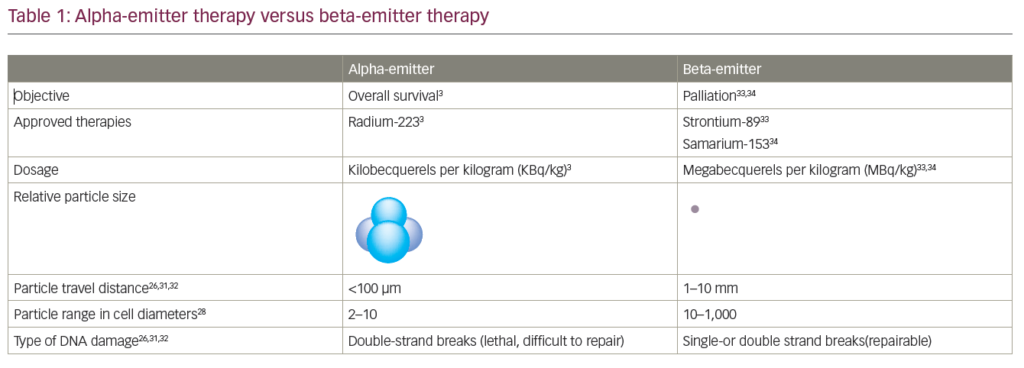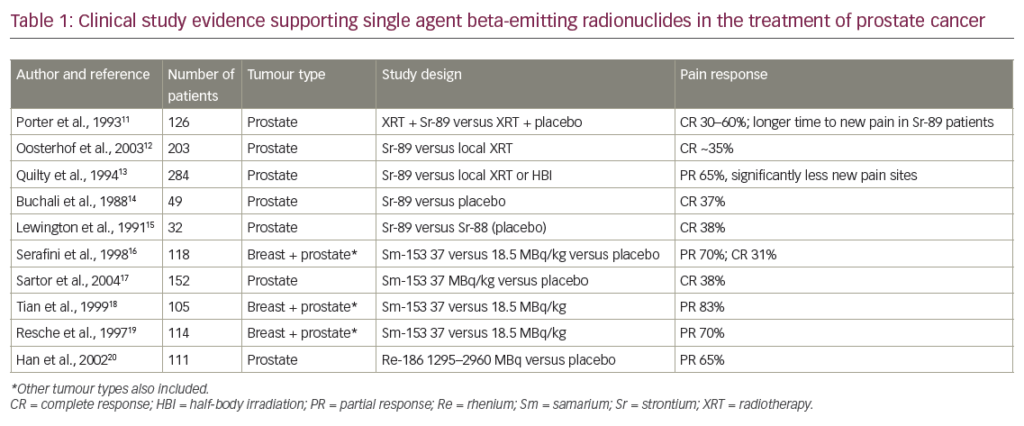Materials and Methods
One hundred and eighteen patients were selected for HIFU treatment of a histologically documented local recurrence after radiotherapy. All patients showed a biochemical recurrence according to the American Society for Therapeutic Radiology and Oncology (ASTRO) criteria. No patients had metastases on bone scan, abdominal computed tomography (CT) scan and/or pelvic magnetic resonance imaging (MRI).
The mean radiotherapy dose was known in 89 patients: 68.8 Grays (range 56–88 Grays). The mean interval between radiotherapy and HIFU treatment was 56.5 months (4.1 years).
Fifty-nine patients received hormone therapy in combination with external radiotherapy or because of biochemical recurrence following radiotherapy. All hormone therapies were discontinued at the time of HIFU treatment.
Treatment with High-intensity Focused Ultrasound
Treatments with HIFU were performed using the ABLATHERM® device manufactured by EDAP-TMS (France). From October 1995 to March 2002, treatments were given using standard parameters. From September 2002 onwards, specific treatment parameters were defined to take account of the poor vascularisation of the prostate gland and peri-prostatic tissue as a result of the fibrosis induced by irradiation. These parameters were calculated using the mathematical model developed by INSERM. The principal objective was to eliminate the risk of rectal lesions caused by an excessive thermal dose delivered to the gland. Sixty-three patients were treated with these specific parameters.
Treatments were performed under spinal anaesthesia, except in the case of contraindications requiring general anaesthesia.
HIFU treatment was given by adjusting the volume treated as precisely as possible to the volume of the gland. In general, treatment was administered in four successive blocks (two per prostate lobe). The catheter replaced at the end of treatment was withdrawn on the fourth day post-operatively. The integrity of the rectal wall was monitored in all patients by MRI with gadolinium injection (and by rectoscopy in the event of abnormalities detected on MRI).Patient Follow-up
Patients were followed up regularly and adverse events recorded. Urinary incontinence was evaluated using the Ingelman-Sundberg score, grade 1 to 3. Prostate-specific antigen (PSA) was checked every three months during the first year of follow-up and then every six months subsequently. Follow-up biopsies were performed in all patients three months after the HIFU treatment and repeated at least once in the event of a rising PSA. The assessment of metastasis (bone scan and thoracoabdominal CT scan) was repeated in the case of a biochemical relapse. Some patients suffering from residual cancer without identifiable metastases received a second HIFU session. Hormone therapy was introduced in the case of residual cancer after one or two HIFU sessions and/or in the case of a biochemical recurrence (three successive rises of PSA). Follow-up was defined as the interval between the last HIFU treatment and the last measurement of PSA without hormone therapy. The event used to define progression-free survival rate was the institution of hormonal treatment (with the date of institution of the hormonal treatment as the date of failure).
Results
One hundred and thirty-one HIFU sessions were undertaken in 118 patients (1.1 session per patient): one session in 99 patients and two sessions in 19 patients. The mean post-operative catheterisation time was five days (range 2–46). The prostate volume decreased progressively as the necrotic tissue was eliminated during the months following treatment: the volume measured three months after treatment was 13.4±9.44cc (median 13cc) versus 18.6±9.22cc (median 18 CC) before treatment. The mean follow-up of all patients was 16.4 months. Follow-up biopsies were negative in 99 patients (84%). The median nadir PSA was 0.18ng/ml. Sixty-one patients (52%) required no hormonal treatment: they had negative follow-up biopsies and their PSA levels remained stable. Fifty-six patients (40%) required hormonal treatment because of the persistence of cancer foci in the follow-up biopsies (18 patients) or because of a biochemical recurrence without residual cancer in the biopsies (30 patients). Metastases appeared during hormonal therapy in 13 of the 56 patients, of whom six died as a result of cancer progression (specific death) after institution of treatment by chemotherapy.
The specific survival rate was 71% at 60 months. Actuarial progressionfree survival rate, which was dependent on the initial risk, was respectively 78% for low-risk patients, 49.5% for intermediate-risk patients and 14% for high-risk patients (p=0.0002). PSA levels at the time of HIFU treatment did not affect actuarial progression-free survival rate.
Side Effects
The early complications were essentially acute retention occurring within three months of treatment and due to the migration of necrotic debris into the prostatic urethra. Four patients treated during the period 1995–2002 with the standard parameters developed a urethrorectal fistula: these fistulas occurred between two and six weeks after treatment. Uretrorectal fistula disappeared completely after 2002 with the use of specific parameters for the treatment of patients with radiation failure. Forty-three per cent of patients suffered from urinary incontinence, 23% of them severe, grade 2 or 3. An artificial sphincter was implanted in 11 patients. The frequency of grade 3 incontinence was reduced from 16 to 5% with the use of specific parameters after 2002. Likewise, the rate of stenosis of the prostatic urethra and/or bladder neck was reduced from 35 to 6%. Erectile function was not evaluated in this cohort as sexual function was preserved in very few patients at the time of HIFU treatment.
Discussion
The decision to administer salvage treatment after external radiotherapy assumes two pre-conditions. First, the local recurrence must be histologically demonstrated. Second, the absence of distant metastases must have been confirmed.
To document the local recurrence, biopsies must therefore be performed in patients with a biochemical recurrence. There is no consensual PSA threshold for performing this diagnostic procedure, but there is a problem of timing as the biopsies must be interpreted with caution during the months following the end of radiotherapy: the presence of neoplastic cells during the two years following radiotherapy should not be interpreted as a local recurrence. After this period, we believe that the presence of neoplasic cells should be considered pathological on condition that biopsies are performed when a biochemiacl recurrence is observed (in our cohort the mean interval between radiotherapy and treatment with HIFU was four years).
Demonstrating the absence of distant metastases is difficult: the sensitivity of the bone scan with 99mTc-phosphonates is limited. Likewise, the thoraco-abdominal CT scan and/or MRI do not detect lymph node micrometastases. 18F-fluorocholine or 11C-choline positron emission tomography (PET)/CT imaging is one possible solution to this problem. Several studies with these markers show that these techniques can detect local recurrences, lymph node and bone metastases at an early stage.
In the cohort, 30 patients suffered from a biochemical recurrence with no local recurrence detectable by follow-up biopsies during the months following HIFU treatment (whereas the assessment of spread undertaken before HIFU treatment was negative).
In this study, progression-free survival rate was significantly correlated with the initial status of the cancer before radiotherapy: it is logical to think that the poor results obtained in high-risk patients (stage T3 or PSA ?20ng or Gleason score ?8) are related to the presence of micrometastases not detected by the standard examinations.
We currently propose to perform an 18F-fluorocholine (FCH) PET/CT scan in patients at high risk of metastasis: we hope that this examination will allow a better selection of patients who are candidates for salvage treatment with HIFU by better identifying metastases, thus contraindicating the HIFU salvage treatment. In the published series of salvage treatment following external beam radiotherapy, the best results are obtained by surgery. This type of therapy is offered only to patients capable of tolerating major surgery and in practice only a very small proportion of patients with local recurrence after radiotherapy can be candidates for this type of treatment. It is interesting to note that the Gleason score at the time of recurrence significantly affects the results of salvage surgery, which was also demonstrated in our cohort. The results of cryotherapy and brachytherapy are inferior to those of surgery, but it is probable that, as in our series, the patients did not undergo as strict a selection process as in the surgical series. The specific survival rate after HIFU is comparable to that for surgery, despite the predominance of high-risk patients in the cohort (53% of patients). The rate of negative biopsies is high (84%). After treatment with HIFU, progression-free survival rates are very high for low- and intermediate-risk patients (70% and 50%, respectively).
In comparison with the principal techniques, treatment with HIFU has an acceptable morbidity over the whole inclusion period and has improved markedly with the technical progress achieved recently in the Ablatherm device: the risk of rectal lesions has disappeared since the development of specific parameters for the treatment of patients with failure following radiotherapy. The rates of stenosis and grade 3 incontinence have also declined with the reduction in the thermal dose.
Conclusions
Treatment with HIFU allowed local tumour control in 84% of patients treated for prostate cancer recurrence after radiotherapy, but disease control depended on initial risk factors and Gleason score at the time of recurrence. High-risk patients (T3 or PSA>20 or Gleason score ?8) are not good candidates for salvage treatment with HIFU: they must be strictly selected (18F-fluorocholine PET scan) as the majority have silent metastases associated with the local recurrence. Conversely, treatment with HIFU is a very interesting curative option for low- or intermediate-risk patients, particularly if the Gleason score of the local recurrence is ?7.















